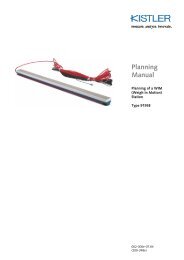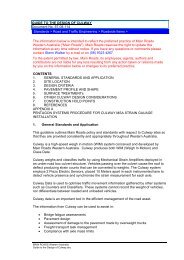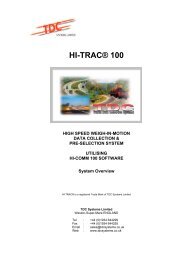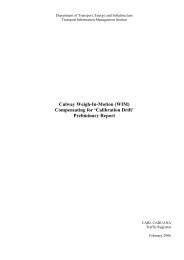AP-G84/04 Best practice in road use data collection, analysis ... - WIM
AP-G84/04 Best practice in road use data collection, analysis ... - WIM
AP-G84/04 Best practice in road use data collection, analysis ... - WIM
You also want an ePaper? Increase the reach of your titles
YUMPU automatically turns print PDFs into web optimized ePapers that Google loves.
Accessed by AR - ARRB TRANSPORT RESEARCH on <strong>04</strong> Feb 2005<br />
Table 13 - Suggested volume stratification of <strong>road</strong> segments<br />
Stratum Suggested range<br />
for urban <strong>road</strong>s<br />
(AADT)<br />
1<br />
2<br />
3<br />
4<br />
5<br />
6<br />
7<br />
8<br />
9<br />
10<br />
0-300<br />
301-1,100<br />
1,101-2,000<br />
2,001-4,000<br />
4,001-7,000<br />
7,001-16,000<br />
16,001-20,000<br />
20,001-35,000<br />
35,001-50,000<br />
50,000 plus<br />
Aust<strong>road</strong>s 20<strong>04</strong><br />
— 27 —<br />
<strong>Best</strong> Practices <strong>in</strong> Road Use Data Collection, Analysis and Report<strong>in</strong>g<br />
Suggested range<br />
for rural <strong>road</strong>s<br />
(AADT)<br />
0-100<br />
101-300<br />
301-700<br />
701-1,100<br />
1,101-2,000<br />
2,001-4,000<br />
4,001-7,000<br />
7,000 plus<br />
Homogeneous or uniform traffic sections should be determ<strong>in</strong>ed <strong>in</strong> a consistent way based on a<br />
predef<strong>in</strong>ed set of rules. Road authorities would have their own <strong>in</strong>dividual procedures <strong>in</strong> def<strong>in</strong><strong>in</strong>g<br />
and process<strong>in</strong>g homogeneous sections. An example of rules for def<strong>in</strong><strong>in</strong>g homogeneous traffic<br />
section, sourced from Ma<strong>in</strong> Roads WA and Transit NZ and reported below. those rules can be<br />
<strong>use</strong>d as a start<strong>in</strong>g po<strong>in</strong>t to generate traffic sections that can be reviewed by stakeholders with local<br />
knowledge for consistency and accuracy. Each homogeneous section to be selected up to its<br />
maximum length, <strong>in</strong>clud<strong>in</strong>g ramps;<br />
Homogeneous sections to be delimited by <strong>in</strong>tersections with arterial and sub-arterial <strong>road</strong>s;<br />
A homogeneous section should not extend over two <strong>road</strong>s;<br />
A homogeneous section should not conta<strong>in</strong> a s<strong>in</strong>gle and dual carriage way or a ‘one-way’<br />
<strong>road</strong>;<br />
A homogeneous section cannot span across different speed zones<br />
The start and end po<strong>in</strong>ts of homogeneous sections should not co<strong>in</strong>cide with start and end<br />
po<strong>in</strong>ts of strategic l<strong>in</strong>ks (cannot have a homogeneous section overlapp<strong>in</strong>g the lengths of two<br />
consecutive strategic l<strong>in</strong>ks); and<br />
A difference <strong>in</strong> AADT volumes between two consecutive count sites of 15 - 100% generates<br />
a new traffic section, as shown <strong>in</strong> Table 14. Similar rules can be applied <strong>in</strong> regard to traffic<br />
composition.

















